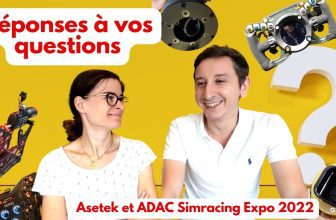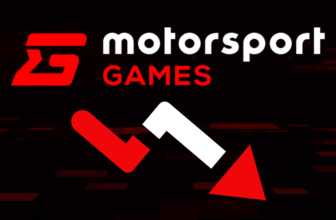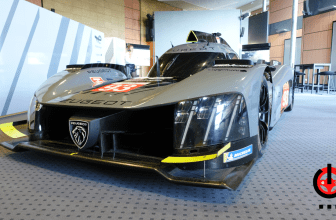This week, I bring you an interview with pro driver Antoine Leclerc. But first, a little background! A few weeks ago, I had the pleasure of visiting the Circuit Paul Ricard to attend the Fanatec GT World Challenge Europe. But if everyone (well… among motorsport enthusiasts) knows about the GT World Challenge, thanks in part to Assetto Corsa Competizione , the official game. Fewer know that there are actually a ton of other races around these meetings.
Lamborghini Super Trofeo, McLaren Trophy Europe, GT4 European Series, GT4 Scandinavia, GT1 Sport Club and even SimRacing with the SRO eSport SIM Pro Series. These weekends are an opportunity to literally feast your eyes and ears.
And among all the throngs of spectators, mechanics and drivers, it’s Code Racing Development and driver Antoine Leclerc that I’ve chosen to focus on. I think you’ll quickly understand why when you read the interview, so I’ll leave you in peace to meet Antoine properly.
Hello Antoine Leclerc, could you briefly introduce yourself?
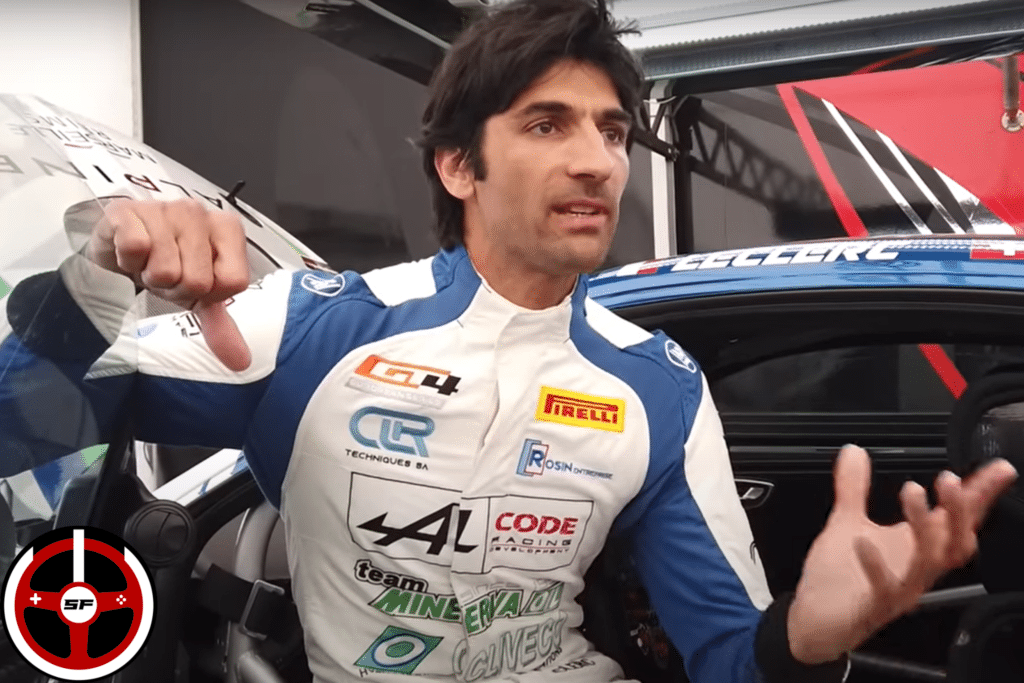
Antoine Leclerc, professional racing driver. I’m here today in the GT4 European Series, as I’m an Alpine driver and brand ambassador. This is my third season in this championship and my second with Code Racing Dévelopment. This weekend we’re at the Circuit Paul Ricard for the second round of the championship.
Could you tell us about your career path?
I started out in karting, and I always wanted to be a racing driver. It’s been an obsession of mine ever since I was a kid. My first memory is of karting, loc karting. Then single-seaters. I soon moved on to GT, because I didn’t have the partners or the means to develop at a higher level in single-seaters. And as I really wanted to make a career out of it, I said “OK, we’ll have to think about it”.
I was lucky enough to meet Philippe Alliot, who said to me: “If you don’t have the means to do single-seater racing at the highest level, it’s not worth it
single-seater racing at a higher level, there’s no point in continuing. Come to GT and try out what it’s like
a big racing car with doors!”
When you’re young, it’s all about F1, F1, F1. And I’d never really looked at GT. I went to a race in Bahrain, I liked it, and that’s how my career started in
GT. I was French champion in 2008. It launched my career at international level. I went on to become a McLaren Art Grand Prix driver. Bentley as Bentley Boy. So I’ve spent most of my career in Grand Touring.
What’s your very first motorsport memory?
Well, it’s not racing, it’s when I was very small on an electric train that I asked my parents to make. At first, it was on 8″ rails, but very soon I took off the rails and was actually doing my circuit in the living room with my electric train. And then, more seriously, it was in karting the day I managed to convince my parents and father to put my butt in a kart bucket.
Once I’d got a taste for it, it was every evening as soon as I got out of school, I’d head for the indoor kart track and do laps and laps. And since I was light and the times were pretty good, all the guys who came to drive – since I had the track record – wanted to beat me. So they paid for me to ride with them the next session. And that’s how I was able to do two hours of karting without it costing me 1 euro! Well, that was in francs back then, in ’95-’96.
You used to be an F1 fan, but what category really stands out for you today?
F1! My childhood was Prost/Senna. I was pro-McLaren, but perhaps a little more pro-Senna, because Ayrton had that panache in qualifying and that drive in the race. But I also admired Alain Prost, who had an exceptional knowledge of racing and car tuning.
Then there was Le Mans! The 24 Hours of Le Mans, that’s for sure. Today, it’s the last box I’d like
to tick before the end of my career. I’ve been French Champion, I’ve been a factory driver. But I’ve never taken part in the 24 Hours of Le Mans. I’ve never had the opportunity, it’s never gone well. So it’s really something I’d like to make happen.
So, yes, it’s F1 because it makes everyone dream and then it’s Le Mans. This year there’s a magnificent centenary edition, with many manufacturers returning to the premier class. So Le Mans and this 24-hour race are just incredible. I’ve already experienced it sometimes as a spectator… As a privileged spectator in the pits and so on. But one day I’d like to experience it as a driver.
Discover: Our meeting with Gustavo Menezes, Peugeot 9X8 driver at the 24h du Mans 2023
More specific question: what’s the feel you want from a brake pedal?
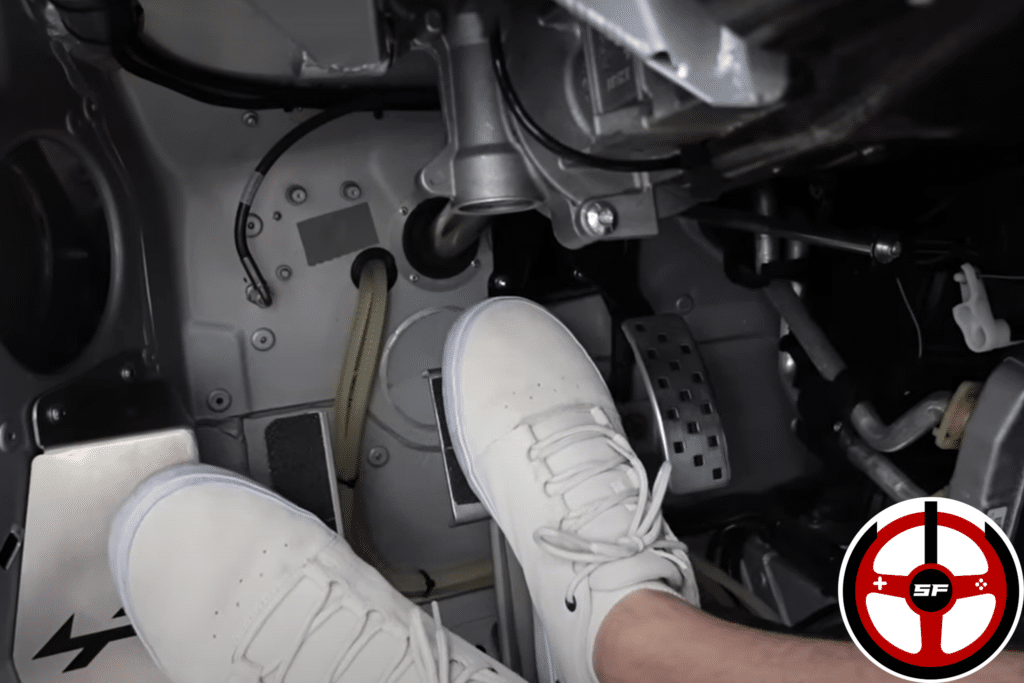
A good brake pedal is one that’s consistent, that doesn’t stretch out and that’s always
always constant. Consistent and constant. That’s what I like about it, and it allows you to brake the way you want, with the right pressure, the right degression, etc. How much force do you need to put on the brake?
How much brake force do you need on the GT4?
In GT4, we’re talking about 80-85 bar maximum. In bigger cars like the GT3s , we’ll go up to 120 bar on very heavy braking. It’s really a question of using the muscle power of the left leg and the left foot. Since we brake a lot with the left foot
left foot in these cars.
In terms of pedal travel, do you prefer short or long pedals?
Quite short! With consistency, as I was saying. With not too much pedal length. Personally, I prefer pedals with enough consistency to allow me to… In any case, they give me a good feeling with them, so I can reproduce the same thing at every turn.
Do you use SimRacing or Pro Simulators?
Yes, it’s something we use. It’s a tool that allows me to prepare for meetings and rehearse notes. Things change from one year to the next. So, even if you know a circuit
to remember certain things. Things that we were able to implement at the previous meeting. And when we come back to the circuit, we can work in SimRacing to save a little time on the track on the big day.
Is there really anything you can learn from this as a driver?
Of course, and then I do a lot of coaching, accompanying both young junior drivers and Gentlemen Drivers. And that’s another reason why we use it, to save time and prepare our drivers before the meeting, so as to save them time.
In GT4 , there are two drivers, in GT3 it’s 3. Having raced in the Pro-Am last year in GT3 at the 24h de Spa , it’s even four drivers. So driving time is very short when you divide it by four! So arriving prepared and having set things up in advance saves time and allows you to be more efficient during the test sessions.
What limitations do you still feel between SimRacing and reality?
Yes, of course. In sim, there’s no psychological barrier. If I take a corner like the Raidillon, well, if in the Raidillon you lose the car in sim, it’s not a big deal. You finish the lap, or you reset and start again. So sometimes it’s true that some drivers lose their inhibitions when they’re going flat out on every lap, and don’t pay the same attention on the Raidillon.
In real life, the Raidillon is a challenge every lap! I’m taking this turn because a lot of people know about it. It’s really a challenge every lap! Whether you’re testing, qualifying, racing… The Raidillon remains a challenge and it’s a corner where you have to be hyper hyper focused, concentrated. Because where you ease off, where you steer, will determine your exit. If you steer too early, you can hit the vibrator on the inside and destabilize the car. And if you turn too late, you miss the line and that can also be detrimental on the exit of the bend.
Then there’s an uphill false flat to Combes. That’s in the “least worst case scenario”, but in the worst case scenario you could lose the car by hitting the vibrator on the inside if you steer too late… Which is something we forget a bit in Sim Racing.
I would like to take this opportunity to remind you that every week we offer you a Trajectory Tutorial produced by a real track instructor. The opportunity to know precisely the landmarks to follow to pass the Raidillon 😉
The Circuit Tutorial Spa-Francorchamps
What advice would you give to a young person wanting to get into SimRacing or real racing?
If you want to make a career out of it, or at any rate if you want to get to grips not only with sim racing but also with real racing, the simulator can be a good place to start. Because it teaches you about circuits and trajectories. And then you need to do karting and have a lot of financial backing to be able to progress. Because today, it’s true that that’s the key. Clearly, you need the financial backing to progress and join the right teams. And we see this at every level, starting with karting!
Then you can get into an industry that offers greater support. But in the beginning, that’s the basis. If you go back 25 years, I’d never have been able to do karting the way I did if we’d had the budgets we spend today to develop it.
Even if you’re talking about a regional or national level, not to mention international, you already need very substantial resources. And if we want to play on equal terms with the competition, unfortunately that’s the only way. Otherwise, you’re not on an equal footing. And in motor racing, it’s hard when you’re not on an equal footing.
You also have rally experience, what has that brought you?
I took part in my first rally a year and a half ago. It was the Rallye Sainte Baume, a circuit rally at the wheel of an Alpine. And I loved the format! First of all, the sharing with the co-driver and then the fact of spending a lot of time in the car. You set off in the morning and choose your tires for the loop ahead. It’s generally three stages. And we alternate between low time on the liaison and high time on the special stages.
We go back to the assistant, correct the notes for the second lap and watch the videos again. We share our tire choices with the team. Conditions can change, so there’s another tire choice to make for three special stages.
It’s really fun, because you really have to think! You have to know how to lose some in one stage to gain more in the other. So all that is something we’re more used to on the track today. On the track, it’s Slick or Rain, at least in the GT categories. Often with a single manufacturer.
That’s not the case in rallying. There’s a lot less waiting involved than on the track. We talk in the morning, come back at lunchtime, leave again in the early afternoon and come back in the evening. And so we share a lot with the co-driver about high and low points. And that’s great, it’s something I really enjoyed.
It was a complete change from what I’ve been doing for 20 years on the circuit, and I loved it! So we did it again in December last year, 6 months ago. On the same rally that we won this time, so I’m keen to keep going and do it again. I’ll be at the start of the Sainte Baume in 2023, again at the wheel of the Alpine, but this time in the RGT rally version. And maybe more if affinity.
OK, so it’s taking up more and more of your time?
Not more and more, because this year we looked at what we could possibly do in the French championship. And unfortunately there are a lot of clashes of dates with the GT4 Europe program plus the programs I’m involved in as a coach. Nevertheless, it’s not impossible that there could be a second one in addition to the Sainte Baume, which is out of season as it’s in December. So we’re thinking about it, it’s not impossible.
What can we wish you for the next 12 months?
Look, our clear objective this year with Code Racing Development and Alpine is to win the European Championship. We won some races last year and we’ve already won some this year at the first meeting of the season at Monza. We won both, but we took a penalty on the first, so unfortunately we lost the victory points, but we won the next day. That’s what it’s all about: being consistent, scoring points, being there all the time. And then we hope to be there at the last one in Barcelona for the final and fight for the title.
A big thank you to Antoine Leclerc!
Thank you to Antoine for taking the time to talk to us. A few hours after this interview, Antoine Leclerc and his teammate Loïc Villiger finished second in the Pro-Am category. But it was the following day’s race that was the most impressive. Again at Le Castellet, after a fine start to the race, the rain invited itself in for the last third of the race. With most of the cars still on Slick tires, we were treated to a veritable glide-fest. But above all, we were treated to a driving masterclass by our two comparses, who won the event in their category in apocalyptic conditions!
I invite you to keep a close eye on these two drivers, who have not finished surprising us in the 2023 GT4 European Series season.
- Antoine Leclerc’s Instagram
- Loïc Villiger’s Instagram
- The replay of the second race (a must see, she’s incredible!)




